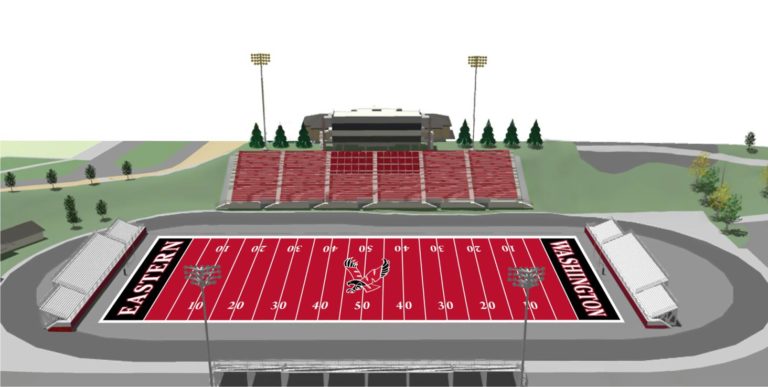Former Eastern Washington University football standout Michael Roos of the Tennessee Titans has pledged $500,000 toward the university’s “Red Turf” project at EWU’s Woodward Field in Cheney, WA, Eastern President Rodolfo Arévalo announced last week.
The project is slated to take on a very unique twist with the installation of the red synthetic playing surface. The red artificial field will be the first of its kind, not just in NCAA Division I football, but in the entire country.
Eastern Athletic Director Bill Chaves, who is working with associate athletic director for development Marc Hughes on the project, said EWU needs to secure additional funding through private contributions before actual replacement can be started. It is hoped that the project can be funded and completed in time for the 2010 season.
“There is no doubt that one of Boise State’s claim to fame has been their blue turf and like it or dislike it, it has certainly brought them a tremendous amount of notoriety,” said Chaves. “In a similar vein we have a tremendous opportunity at Eastern to do the same by differentiating ourselves with the red turf while providing a superior playing surface.”
The project was jump-started with a generous initial gift from Roos and his wife Katherine, who are both graduates of Eastern. Roos graduated in 2005 with a double major in Finance and Economics, and Katherine graduated in 2004 with a degree in Urban and Regional Planning. They now reside in Nashville, Tenn., where Roos earned All-Pro honors for the Titans in 2008. He has started all 80 regular season games as a Titan, plus two playoff games, 21 pre-season games and the 2009 Pro Bowl.
“We cannot thank Michael and Katherine enough for their generous gift,” said Chaves. “As former student-athletes, their leadership takes the thought of ‘learning, earning and returning’ to an entirely new level. Our hope is that this will inspire others to join Michael and Katherine in helping complete this project. We are sincerely grateful.”
Arévalo echoed comments made by Chaves in appreciation of the gift. “In this most challenging of budget environments it is difficult to allocate funding to areas outside the classroom, which makes external support of this magnitude so critical,” said Arévalo. “Michael and Katherine are to be commended for their philanthropic efforts with Eastern and their community through their foundation, the Michael Roos Foundation.”
Roos played at Eastern from 2001-04, and ended his Eagle career with 35-straight starts. As a senior in 2004, he earned five different All-America honors and was the NCAA Football Championship Subdivision (then I-AA) Lineman of the Year. Roos was drafted in the second round (41st pick overall) by Tennessee in the 2005 draft.
“I am grateful for my time at EWU,” Roos said. “Not only did I meet my wife during my time at the university, but Eastern’s leadership, coaches and football program paved the way for my professional success in football. It is exciting to be able to give back.”
Eastern head football coach Beau Baldwin sees several significant advantages thanks to this investment. “First of all, the generosity and loyalty Michael Roos has shown to our football program at EWU are unparalleled,” Baldwin said. “Top to bottom, the players and coaches -everyone associated with our program – knows it’s a sizable and generous gift, and can’t be more excited about the opportunity to play and practice on the new surface.
“It’s huge for recruiting because potential student-athletes can see the progress we are making and the positive direction of our program,” he continued. “With all the different events that can take place at Woodward Field and a stronger game-day experience, it’s bound to bring more exposure to our program. We already feel proud about the great things we are doing, but hopefully this project will help us be even bigger and better.”
Besides the obvious advantages of synthetic turf in inclement weather, Baldwin’s team typically has additional practice issues late in the season in dealing with darkness and class schedules. With artificial turf, the Eagles can practice on their game field under the lights at their convenience with minimal field condition worries.
“When all is said and done, the most important aspects of this Red Turf project are the ways it benefits student-athletes at EWU,” he added. “It gives us a surface that’s better to play on, and it’s extremely important for us to be able to practice on our game field more often.”
Built in 1967, the stadium has had a grass field since its inception. Modern artificial turf provides a safe, fast, low-maintenance surface for football, and is particularly desirous in regions with inclement weather. Eastern will be the sixth of nine universities in the Big Sky Conference to convert to artificial turf. The turf installation will also benefit EWU and the environment through a savings of approximately 300,000 gallons of water per year.


